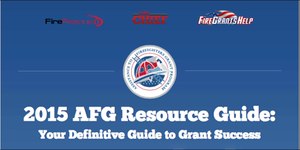
The six-week AFG period overlapping with the holidays makes it all the more important to have the application done right
Dec 1, 2015
It is official, the 2015 Assistance to Firefighters Grant application period will open at 8 a.m. Dec. 7, and close Jan. 15 at 5 p.m.
A number of us aren't too happy with the idea that we may be wrapping our presents while wrapping up our AFG application. So here are a few simple tips to ensure that you can begin the day the application period opens and complete it with time to still enjoy the holidays.
The first and most important tip is to have a Data Universal Numbering System number and be registered in System for Award Management. If you don't have both of these, get them immediately.
It may take four weeks or more after SAM registration submittal before it is active — then add an additional 24 hours for Grants.gov to recognize the information. Information on obtaining a DUNS number and registering in SAM is available here .
Next, if you haven't decided on a project, do so in the next week. Once you have a project, check the Notice of Funding Opportunity to see if it is eligible and if it is ranked as a high priority by FEMA. With limited funding, medium- and low-priority projects stand very little chance of being funded by AFG.
Project data
After that, secure a cost estimate for your project. Remember, since the 2013 AFG, FEMA no longer allows applicants to ask for amendments to their awards for remaining amounts over $10,000.
There are several avenues to get that cost estimate and still be in compliance with Super Circular 2.
Super Circular 2 went into effect at the end of 2014 and this will be the first application period that it impacts those seeking cost estimates before the opening of the grant.
The next item on your list should be securing all the data for your application. This year there is a change in the way AFG is requesting call volume data under the application's characteristics section.
FEMA previously used its own system of categories for designating different types of alarms. This year it will use the NFIRS format. This should allow those departments that are reporting to NFIRS to smoothly complete the call volume section.
There are six other changes to the 2015 AFG application worth noting.
1. Equipment priorities for nonaffiliated EMS
As the basic mission of nonaffiliated EMS organizations is to provide BLS and ALS care and transport in support of the public and emergency responders, all rescue and extrication equipment will now be considered a medium priority for EMS organizations.
2. Product lifecycles
Historically, for most eligible equipment (hose, ladders, hand tools, etc.), the highest funding priority was for equipment 15 years or older or considered obsolete based on the NFPA 1851 standard.
However, for 2015 the useful operational life of EMS technology-based equipment has been adjusted to an 8-year replacement lifecycle in many cases. EMS technology-based equipment categories have been marked with "technology" in the funding priority chart available in NOFO Equipment, Appendix B, II.
3.Transitioning titles in EMS
The U.S. Department of Transportation, under the National EMS Scope of Practice Model, is in the process of changing titles for EMS providers. Under this program, the titles below are changing and FEMA will incorporate these changes into each grant cycle.
4. Tablets
Mobile computing devices intended to be used at the scene of an incident are now considered a high-priority item under communications.
5. SCBA
AFG considers a complete SCBA Unit to be comprised of the harness/backpack, one face piece and two cylinders.
6. Community paramedic vehicle
This year no transport community paramedic vehicles have been moved to a high priority item under all vehicle classifications for AFG.
Copyright © 2025 FireGrantsHelp.com. All rights reserved.
